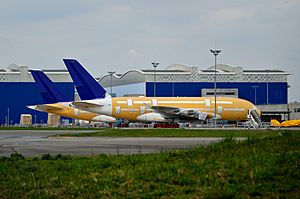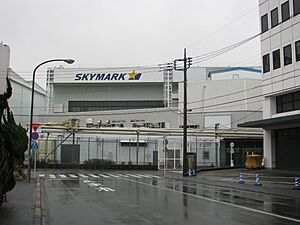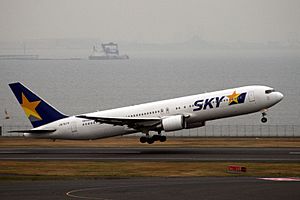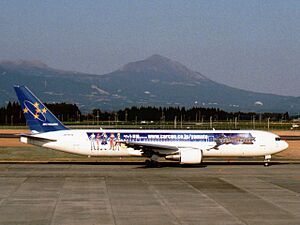Skymark Airlines facts for kids
| Founded | November 12, 1996 |
|---|---|
| Commenced operations | September 19, 1998 |
| Operating bases |
|
| Fleet size | 29 |
| Destinations | 11 |
| Headquarters | Haneda Airport, Ōta, Tokyo, Japan |
| Key people |
|
| Revenue | |
| Operating income | |
| Net income | |
| Total assets | |
| Total equity | |
| Employees | 2,457 (31 March 2024) |
Skymark Airlines is a Japanese airline based in Tokyo, Japan. It flies to many places within Japan. Its main base is at Haneda Airport in Tokyo. Skymark also has important bases at Kobe Airport and Naha Airport. It is known for being the first low-cost airline in Japan.
Contents
Skymark Airlines: A Japanese Airline
Skymark Airlines was started in November 1996. It began flying on September 19, 1998. The airline was created after new rules made it easier for new airlines to start in Japan. Its goal was to offer flights at lower prices than other big airlines.
Early Flights and Growth
Skymark quickly got flight slots at Haneda Airport in Tokyo. Its first flight was from Haneda to Fukuoka. Over time, it added more routes to cities like Sapporo and Kagoshima. In its early years, Skymark faced some challenges and lost money.
In 2003, a new investor, Shinichi Nishikubo, helped the airline. He became the CEO in 2004. Skymark then started to make a profit by using more efficient planes and systems. They wanted to offer cheaper tickets than bigger airlines like JAL and ANA.
Skymark also worked with Japan Airlines for a while. They shared flights on some routes. Skymark also became a major airline at Kobe Airport.
Trying New Planes and Services

In 2010, Skymark considered buying very large Airbus A380 planes. They planned to use these planes for long flights to cities like London and New York. The idea was to offer a special "premium" service with very comfortable seats.
Around 2012, new low-cost airlines started flying in Japan. This made it harder for Skymark to compete on some routes. To stand out, Skymark decided to use Airbus A330 planes for domestic flights. These planes had special "Green Seats" that were more spacious and comfortable. This was meant to attract business travelers.
Financial Challenges and Changes

Skymark faced money problems starting in 2014. The value of the Japanese yen changed a lot. This made it more expensive for Skymark to pay for its planes and fuel, which were priced in US dollars. Because of this, the airline started losing money again.
Airbus, the company that makes planes, ended Skymark's order for the A380s. This was because Airbus was worried Skymark could not pay for them. Skymark had already paid a lot of money for these planes.
The new A330 planes started flying in 2014. However, they had too many seats for the number of passengers Skymark was getting. This also hurt the airline's finances. Skymark tried to work with other airlines like Japan Airlines and All Nippon Airways to get financial help.
Rebuilding After Difficult Times
In January 2015, Skymark had to file for bankruptcy protection. This meant they needed help to reorganize their business. The airline stopped using the A330 planes and cut some routes.
Later in 2015, a plan was approved to help Skymark recover. A Japanese investment fund called Integral Corporation took control. Other companies like All Nippon Airways and the Development Bank of Japan also invested. This plan helped Skymark get back on its feet.
After leaving bankruptcy in 2016, Skymark's business improved faster than expected. They started adding more flights, especially from their bases in Kobe and Ibaraki. In 2018, Skymark began offering international charter flights to places like Saipan.
Recent Years and Future Plans
Since 2020, the COVID-19 pandemic affected air travel. Skymark had to cancel its international flights. The airline faced financial losses again in 2021 and 2022.
However, Skymark has been recovering. In December 2022, the company's shares were listed on the Tokyo Stock Exchange again. This was a big step after being a private company for eight years.
In January 2023, Skymark announced plans to buy new Boeing 737 MAX planes. These modern planes are expected to start flying for Skymark between 2025 and 2027. This shows Skymark is looking forward to growing its fleet and services.
Where Skymark Flies



As of July 2024, Skymark Airlines flies to 11 destinations, all within Japan. They have flown to more places in the past.
| Country (Region) | City | Airport | Notes | Ref |
|---|---|---|---|---|
| Japan (Hokkaido) | Asahikawa | Asahikawa Airport | Terminated | |
| Sapporo | New Chitose Airport | Base | ||
| Japan (Honshu) | Aomori | Aomori Airport | Terminated | |
| Ibaraki | Ibaraki Airport | |||
| Kobe | Kobe Airport | Base | ||
| Nagoya | Chubu Centrair International Airport | |||
| Osaka | Itami Airport | Terminated | ||
| Kansai International Airport | Terminated | |||
| Sendai | Sendai Airport | |||
| Tokyo | Haneda Airport | Base | ||
| Narita International Airport | Terminated | |||
| Yonago | Miho-Yonago Airport | Terminated | ||
| Japan (Kyushu) | Fukuoka | Fukuoka Airport | Base | |
| Kagoshima | Kagoshima Airport | Base | ||
| Kitakyushu | Kitakyushu Airport | Terminated | ||
| Kumamoto | Kumamoto Airport | Terminated | ||
| Nagasaki | Nagasaki Airport | |||
| Japan (Ryukyu Islands) | Amami | Amami Airport | ||
| Ishigaki | New Ishigaki Airport | Terminated | ||
| Miyakojima | Miyako Airport | Terminated | ||
| Naha | Naha Airport | Base | ||
| Miyakojima | Shimojishima Airport | |||
| Japan (Shikoku) | Tokushima | Tokushima Airport | Terminated | |
| United States (Northern Mariana Islands) | Saipan | Saipan International Airport | Terminated |
Main Routes Overview
This table shows some of the main routes Skymark flies between airports. The "○" symbol means there are flights between those two airports.
| × | × | × | ○ | ○ | ○ | ○ | ○ | Chitose |
| × | ○ | × | ○ | ○ | × | × | Ibaraki | |
| ○ | ○ | ○ | ○ | ○ | × | Haneda | ||
| × | ○ | ○ | × | × | Chubu | |||
| ○ | ○ | ○ | × | Kobe | ||||
| × | ○ | × | Fukuoka | |||||
| × | × | Kagoshima | ||||||
| ○ | Naha | |||||||
| Shimoji |
Skymark's Planes
Current Fleet

As of June 2025, Skymark Airlines uses only Boeing 737 planes. Here's a look at their fleet:
| Aircraft | In service | Orders | Passengers | Notes |
|---|---|---|---|---|
| Boeing 737-800 | 29 | — | 177 | |
| Boeing 737 MAX 8 | — | 13 | 177 | Deliveries are planned for 2026. |
| Boeing 737 MAX 10 | — | 7 | 210 | Deliveries are planned to begin in 2027. |
| Total | 29 | 20 | ||
Planes Skymark Used to Fly

In the past, Skymark Airlines used other types of planes:
| Aircraft | Total | Introduced | Retired | Notes |
|---|---|---|---|---|
| Airbus A330-300 | 5 | 2014 | 2015 | These planes were later sold to other airlines. |
| Airbus A380-800 | 6 | Order cancelled | The order for these very large planes was cancelled. | |
| Boeing 767-200 | 1 | 2003 | 2004 | This plane was leased from All Nippon Airways. |
| Boeing 767-300ER | 6 | 1998 | 2009 | |
How Skymark's Fleet Changed

Skymark first used larger Boeing 767 planes from 1998 to 2005. Some of these planes had special advertisements painted on their sides.
Starting in 2005, Skymark began to use new, smaller Boeing 737-800 planes. By 2009, they had replaced all their 767s with 737s.
During its bankruptcy in 2015, Skymark stopped flying the A330s and most of its 737s. The orders for the A380s were also cancelled. Some of these A380s were later taken by other airlines like Emirates and All Nippon Airways.
Frequent Flyer Program
Skymark does not have its own frequent flyer program. However, since June 2011, members of Delta Air Lines' SkyMiles program could use their miles for some Skymark flights. Skymark flights cannot be used to earn miles in the SkyMiles program.
See also
 In Spanish: Skymark Airlines para niños
In Spanish: Skymark Airlines para niños



